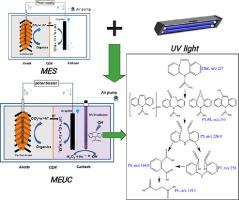Water Research ( IF 11.4 ) Pub Date : 2020-09-23 , DOI: 10.1016/j.watres.2020.116451 Rusen Zou , Kai Tang , Irini Angelidaki , Henrik Rasmus Andersen , Yifeng Zhang

|
Discharge of recalcitrant pharmaceuticals into aquatic environments can lead to serious negative environmental effects. While traditional wastewater treatment plants (WWTPs) are efficient for a wide range of non-toxic pollutants (i.e. ammonia), some wastewater streams contain recalcitrant toxic trace micropollutants such as pharmaceuticals that cannot be removed by the treatment processes that are typically employed in common WWTPs. Herein, an innovative 20 L microbial electrochemical ultraviolet photolysis cell (MEUC) was developed for the first time by the integration of a UV irradiation and a bioelectrochemical system, which exhibited efficient treatment of carbamazepine-a model pharmaceutical compound. Notably, neither the UV irradiation nor the bioelectrochemical system alone could effectively eliminate carbamazepine. The effect of operational parameters including applied voltage, cathodic aeration rate, UV intensity, and hydraulic retention time were evaluated. The obtained results elucidated that the degradation of carbamazepine was consistent with pseudo-first-order reaction kinetics, and required a lower energy input than traditional advanced oxidation processes. Five main transformation products were identified, and probable transformation pathways were established. Furthermore, the eco-toxicity as tested by Vibrio fischeri showed no significant bioluminescence inhibition by the treated carbamazepine effluent. Finally, the MEUC system was further tested with a real wastewater matrix, which again exhibited effective removal of carbamazepine. This paper provides a proof-of-concept verification of the novel MEUC system, which contributes insight for the subsequent vigorous development of the application of such efficient and cost-effective technologies for the treatment of trace pharmaceuticals wastewater.
中文翻译:

一种可有效降解卡马西平的创新型微生物电化学紫外光解电池(MEUC)
将顽calc性药物排入水生环境会导致严重的负面环境影响。尽管传统的废水处理厂(WWTP)可以有效处理多种无毒污染物(例如氨),但某些废水流中仍含有顽固的有毒微量微量污染物,例如无法通过常见WWTP中通常采用的处理工艺去除的药物。在此,通过将紫外线照射和生物电化学系统相结合,首次开发出了创新的20 L微生物电化学紫外光解电池(MEUC),该模型展现了对卡马西平(一种模型药物)的有效处理。值得注意的是,紫外线照射或生物电化学系统都不能单独有效地消除卡马西平。评估了操作参数(包括施加的电压,阴极通气速率,紫外线强度和水力停留时间)的影响。获得的结果表明,卡马西平的降解与拟一级反应动力学一致,并且比传统的高级氧化工艺所需的能量输入更低。确定了五个主要转化产物,并建立了可能的转化途径。此外,通过 确定了五个主要转化产物,并建立了可能的转化途径。此外,通过 确定了五个主要转化产物,并建立了可能的转化途径。此外,通过经处理的卡马西平流出物对费氏弧菌没有明显的生物发光抑制作用。最后,用真实的废水基质进一步测试了MEUC系统,该基质再次表现出对卡马西平的有效去除。本文提供了新型MEUC系统的概念验证,这为随后大力开发这种有效且具有成本效益的技术处理痕量制药废水提供了见识。











































 京公网安备 11010802027423号
京公网安备 11010802027423号